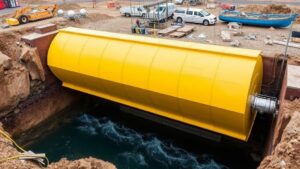Using Explosive Charges Safely in Hard Rock Blasting Operations
Using Explosive Charges Safely in Hard Rock Blasting Operations
Hard rock blasting is an essential process in mining, quarrying, and construction projects that require excavation of tough geological materials. The safe use of explosive charges is critical to ensure the effectiveness of blasting operations while minimizing risks to personnel, equipment, and the surrounding environment. This article delves into the standards, practices, and technologies involved in safe explosive use during hard rock blasting operations.
The Basics of Hard Rock Blasting
Hard rock blasting involves the controlled use of explosives to fragment rock formations to facilitate their removal. This method is particularly necessary in mining operations where ores are embedded in solid rock. Understanding the components of explosive charges, their behavior, and the resulting effects on the rock is crucial for effective blasting.
- Types of explosives used include ANFO (Ammonium Nitrate Fuel Oil), emulsions, and water gels.
- Blasting patterns and timing are carefully planned to optimize fragmentation and minimize vibration.
Regulatory Framework and Best Practices
In many countries, the use of explosives in mining and construction is regulated by strict laws and guidelines to ensure safety. Best practices in hard rock blasting dictate not only compliance with these regulations but also the adoption of industry standards.
For example, the Mine Safety and Health Administration (MSHA) in the United States sets stringent criteria for handling and storage of explosives. Key elements of these regulations include:
- Proper training and certification for personnel involved in blasting operations.
- Regular inspections and maintenance of blasting equipment and storage facilities.
- Useation of safety zones around blasting sites to protect workers and nearby communities.
Risk Assessment and Management
Conducting thorough risk assessments is a vital part of any blasting operation. Before executing a blast, operators must evaluate potential hazards, including:
- Ground vibrations that may affect surrounding structures.
- Noise pollution and its impact on local communities.
- Flyrock and its potential risks to personnel and equipment.
One effective method for managing these risks is the use of vibration monitors and blast analysis software, which tracks real-time data during blasting events. This technology allows operators to adjust blasting parameters to stay within acceptable vibration limits, thereby ensuring safety levels are maintained.
Explosive Charge Design and Useation
The design of the explosive charge is a critical factor in ensuring safety and effectiveness in hard rock blasting. Factors to consider include:
- The type and quantity of explosive materials.
- The design of the blasting pattern, which determines how the explosives will be arranged and detonated.
- The timing sequence of detonations, known as delay timing, to control the energy release over time.
For example, using predetermined delay sequences can reduce vibration and damage to surrounding structures while increasing the overall efficiency of the rock fragmentation process. A study conducted in an underground mining project demonstrated that implementing a precise delay timing system reduced peak ground vibration by up to 30%, underscoring the importance of careful charge design.
The Role of Technology in Enhancing Safety
Advancements in technology have significantly improved the safety of hard rock blasting operations. The introduction of digital tools has revolutionized how operators plan and execute blasts. Technologies such as 3D modeling software and simulation programs allow for more accurate visualization of rock formations and better blast designs.
Plus, remote detonation systems enhance safety by allowing operators to detonate explosives from a safe distance, thereby reducing the risk of injury. In one case study from a surface mining operation, the use of remote detonation resulted in a 50% decrease in near-miss incidents compared to traditional blasting methods.
Conclusion and Actionable Takeaways
Safety in hard rock blasting operations is paramount and relies on a combination of regulatory compliance, risk management, careful planning, and the adoption of innovative technologies. Operations must invest in continuous training and leverage technological advancements to mitigate risks associated with the use of explosive charges.
To enhance safety in blasting operations, consider the following actionable takeaways:
- Regularly conduct comprehensive training sessions for all personnel involved in blasting.
- Use vibration monitoring and blast analysis tools to optimize blasting outcomes.
- Invest in remote detonation systems for safer, more controlled blasting processes.
By prioritizing safety and employing best practices, hard rock blasting operations can effectively achieve their goals while safeguarding their workforce and the surrounding environment.


